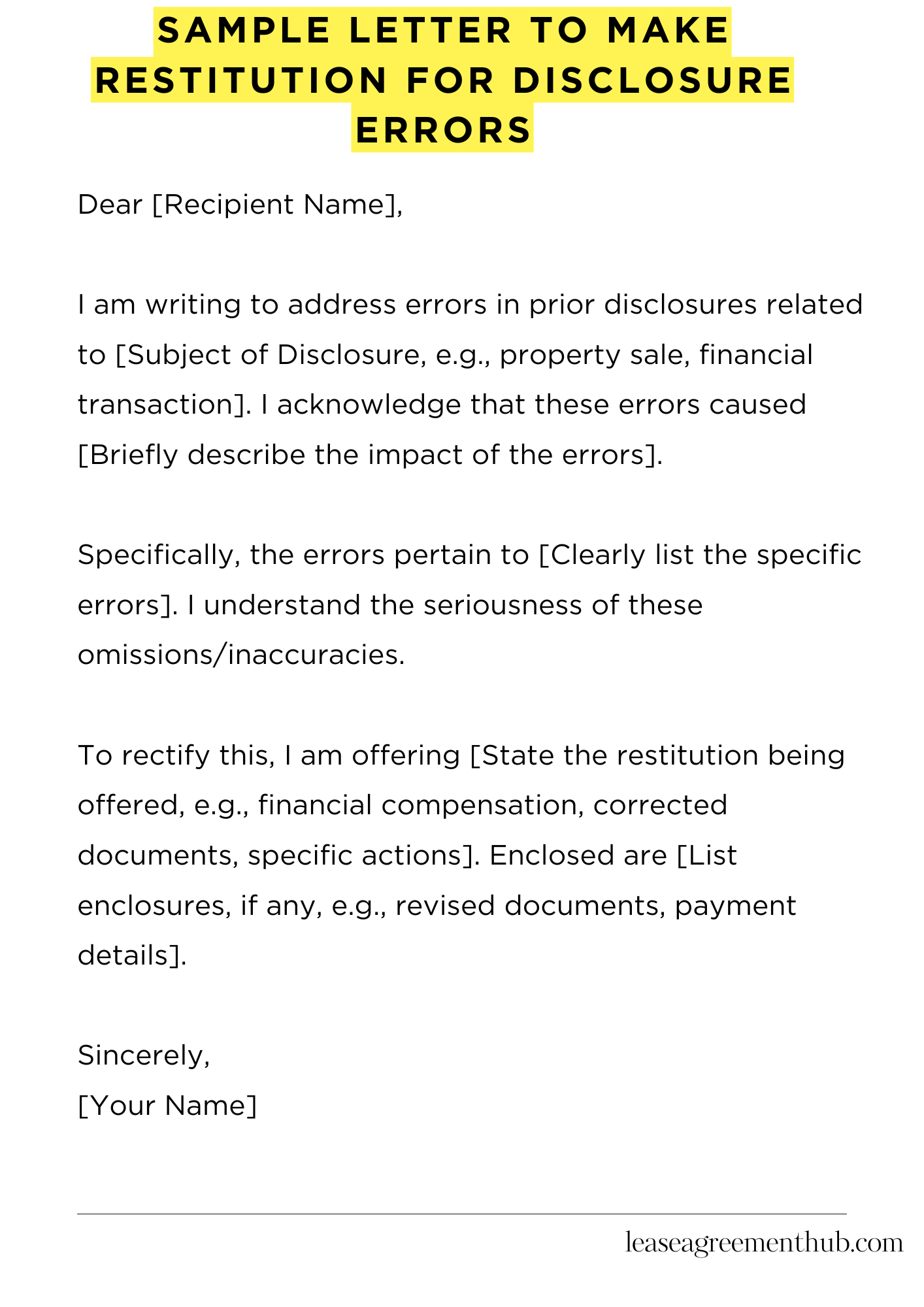A “Sample Letter To Make Restitution For Disclosure Errors” is a formal way to fix mistakes. It’s used when you’ve shared wrong or incomplete info. Think of real estate deals, financial reports, or legal documents.
Need to write one? Don’t sweat it. We’ve got your back.
We’re sharing letter templates. These samples will help you make things right. Let’s get started!
Sample Letter To Make Restitution For Disclosure Errors
[Your Name]
[Your Address]
[Your Phone Number]
[Your Email Address]
[Date]
[Recipient Name]
[Recipient Address]
Subject: Restitution for Disclosure Errors
Dear [Recipient Name],
I am writing to address errors in prior disclosures related to [Subject of Disclosure, e.g., property sale, financial transaction]. I acknowledge that these errors caused [Briefly describe the impact of the errors].
Specifically, the errors pertain to [Clearly list the specific errors]. I understand the seriousness of these omissions/inaccuracies.
To rectify this, I am offering [State the restitution being offered, e.g., financial compensation, corrected documents, specific actions]. Enclosed are [List enclosures, if any, e.g., revised documents, payment details].
I sincerely regret these errors and am committed to resolving this matter fairly. Please contact me if you require further information.
Sincerely,
[Your Name]

How to Write Letter To Make Restitution For Disclosure Errors
Crafting a Compelling Subject Line
- Be direct and unambiguous. A subject line such as “Restitution for Disclosure Omission on [Date]” immediately signals the letter’s intent.
- Avoid vagueness or overly apologetic language. Clarity trumps contrition in the subject line.
Initiating with a Respectful Salutation
- Address the recipient by name whenever possible. “Dear Mr./Ms. [Last Name]” demonstrates perspicacity.
- If the recipient’s name is unknown, use a formal greeting like “To Whom It May Concern,” though personalized salutations are invariably superior.
Articulating the Disclosure Error
- Acknowledge the error forthrightly. Start by stating, “This letter serves to rectify an inadvertent omission in the disclosure provided on [Date].”
- Specify the precise nature of the information that was initially excluded. Scrupulous detail is paramount.
- Explain, succinctly, why the error transpired. Was it an oversight, a misinterpretation, or some other cause? Honesty, tempered with discretion, is key.
Quantifying the Impact of the Omission
- Assess the potential repercussions of the disclosure error. Does it materially affect previous assessments or decisions?
- Outline the steps taken to mitigate any adverse effects stemming from the omission. Proactive measures demonstrate earnestness.
Proffering Restitution and Remedial Action
- Clearly state the remedies being offered to rectify the situation. This might involve financial compensation, revised documentation, or other appropriate actions.
- Provide a concrete timeline for implementing the proposed restitution. Ambiguity breeds distrust.
- Express a willingness to cooperate fully with any further inquiries or investigations. Transparency is indispensable.
Reiterating Sincerity and Accountability
- Reiterate your remorse for the error and reaffirm your commitment to preventing future oversights.
- Emphasize your dedication to upholding ethical standards and maintaining the recipient’s trust.
Concluding with a Professional Closing
- Use a formal closing such as “Sincerely” or “Respectfully.”
- Include your full name, title (if applicable), and contact information.
- Proofread meticulously before sending. Even minor errors can undermine the credibility of your message.
Frequently Asked Questions: Sample Letter To Make Restitution For Disclosure Errors
This section provides answers to common questions regarding restitution letters for disclosure errors. It aims to offer clarity on the purpose, content, and implications of such correspondence.
What is the purpose of a restitution letter for disclosure errors?
The purpose is to formally acknowledge and rectify an error in a previous disclosure, offering compensation or corrective action to mitigate any potential damages caused by the incorrect information.
What key elements should be included in a restitution letter?
The letter should clearly identify the original error, acknowledge the mistake, offer an apology, detail the proposed restitution, and provide contact information for further communication.
How should the amount of restitution be determined?
The amount should be based on a reasonable assessment of the actual damages or losses incurred as a direct result of the disclosure error. Consult with legal or financial professionals as needed.
What is the legal significance of sending a restitution letter?
A restitution letter can demonstrate good faith and a proactive approach to resolving the error, potentially mitigating legal repercussions and fostering positive relations with the affected party.
Should the restitution letter be sent to the affected party directly?
Consult with legal counsel to determine the most appropriate recipient and delivery method, particularly if the error has broader legal implications or involves multiple parties.
Related: